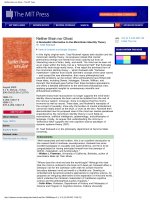the mit press ham radios technical culture dec 2006
Bạn đang xem bản rút gọn của tài liệu. Xem và tải ngay bản đầy đủ của tài liệu tại đây (2.33 MB, 239 trang )
Kristen Haring
Ham Radio’s
Technical Culture
Ham Radio’s Technical Culture Haring
Photograph by Tim Soter
Ham Radio’s Technical Culture
Kristen Haring
Decades before the Internet, ham radio provided instanta-
neous, global, person-to-person communication. Hundreds
of thousands of amateur radio operators—a predominantly
m
ale, middle- and upper-class group known as “hams”—
built and operated two-way radios for recreation in mid
twentieth century America. In
Ham Radio’s Technical
Culture,
Kristen Haring examines why so many men adopt-
ed the technical hobby of ham radio from the 1930s
through 1970s and how the pastime helped them form
identity and community.
Ham radio required solitary tinkering with sophisticated
electronics equipment, often isolated from domestic activi-
ties in a “radio shack,” yet the hobby thrived on fraternal
interaction. Conversations on the air grew into friendships,
and hams gathered in clubs or met informally for “eyeball
contacts.” Within this community, hobbyists developed dis-
tinct values and practices with regard to radio, creating a
particular “technical culture.” Outsiders viewed amateur
radio operators with a mixture of awe and suspicion,
impressed by hams’ mastery of powerful technology but
uneasy about their contact with foreigners, especially dur-
ing periods of political tension.
Drawing on a wealth of personal accounts found in radio
magazines and newsletters and from technical manuals,
trade journals, and government documents, Haring
describes how ham radio culture rippled through hobby-
ists’ lives. She explains why hi-tech employers recruited
hams and why electronics manufacturers catered to these
specialty customers. She discusses hams’ position within
the military and civil defense during World War II and the
Cold War as well as the effect of the hobby on family
dynamics. By considering ham radio in the context of other
technical hobbies—model building, photography, high-
fidelity audio, and similar leisure pursuits—Haring high-
lights the shared experiences of technical hobbyists. She
shows that tinkerers influenced attitudes toward technology
beyond hobby communities, enriching the general techni-
cal culture by posing a vital counterpoint.
Inside T
echnology series
Kristen Haring is a visiting scholar in Columbia University’s
Department of History. She holds degrees in mathematics
from the University of Pennsylvania and the University of
North Carolina at Chapel Hill and a PhD in history of sci-
ence from Harvard University. Haring’s work has been rec-
ognized by the Society for the History of Technology,
which awarded her the IEEE Life Members’ Prize in
Electrical History for portions of
Ham Radio’s Technical
Culture.
She has served on the board of directors of the
Keith Haring Foundation since its creation by her brother
in 1989.
h
istory of technology
“Although approximately one million Americans operated ham radios in the course of the twentieth
century, very little has been written about this thriving technical culture in our midst. Kristen Haring
offers a deeply sympathetic history of this under-appreciated technical community and their role in
contributing to American advances in science and technology, especially the electronics industry. In
the process she reveals how technical tinkering has defined manhood in the United States and has
powerfully constituted ‘technical identities’ with often utopian, even, at times, revolutionary, notions
about the social uses of technology.”
—Susan Douglas, Catherine Neafie Kellogg Professor of Communication Studies, University of
Michigan, and author of
Listening In: Radio and the American Imagination
“Haring’s book is a nuanced and elegantly written cultural history that throws new light on the com-
plex relations among masculinity, domesticity, emotional connection to technology, and American
technical culture.”
—Donald MacKenzie, School of Social and Political Studies, University of Edinburgh
“Kristen Haring has constructed an engaging account of ham radio culture in mid-twentieth-century
America. In so doing, she illuminates how people assign meaning to—and identify with—technologies
of all kinds, thus her book will be of value to all students of technological culture.”
—Emily Thompson, Professor of History, Princeton University
The MIT Press
Massachusetts Institute of Technology
Cambridge, Massachusetts 02142
0-262-08355-8
978-0-262-08355-3
Cover illustrations from Amateur Radio Defense, November 1940, and
Cleveland Institute of Electronics advertisement, CQ, October 1967;
reprinted with permission.
50701Haring 10/31/06 10:55 AM Page 1
Ham Radio’s Technical Culture
Inside Technology
edited by Wiebe E. Bijker, W. Bernard Carlson, and Trevor Pinch
A list of books in the series appears at the back of the book.
Ham Radio’s Technical Culture
Kristen Haring
The MIT Press
Cambridge, Massachusetts
London, England
( 2007 Massachusetts Institute of Technology
All rights reserved. No part of this book may be reproduced in any form by any
electronic or mechanical means (including photocopying, recording, or information
storage and retrieval) without permission in writing from the publisher.
Every effort has been made to contact those who hold rights for all materials repro-
duced here. Any rights holders not credited should contact the publisher so a correc-
tion can be made in the next printing.
MIT Press books may be purchased at special quantity discounts for business or sales
promotional use. For information, please email
This book was set in Stone Serif and Stone Sans on 3B2 by Asco Typesetters, Hong
Kong, and was printed on recycled paper and bound in the United States of America.
Library of Congress Cataloging-in-Publication Data
Haring, Kristen.
Ham radio’s technical culture / Kristen Haring.
p. cm.—(Inside technology)
Includes bibliographical references and index.
ISBN-13: 978-0-262-08355-3 (alk. paper)
ISBN-10: 0-262-08355-8 (alk. paper)
1. Amateur radio stations—History. 2. Radio operators—United States—History.
3. Hobbies—Social aspects. I. Title.
TK9956.H3626 2007
384.540973'0904—dc22 2006046597
10987654321
for my brother, Keith, with abiding love and respect
Contents
Prologue ix
1 Identifying with Technology, Tinkering with Technical Culture 1
2 The Culture of Ham Radio 19
3 Equipping Productive Consumers 49
4 Amateurs on the Job 75
5 Hobby Radio Embattled 95
6 Ham Radio at Home 119
7 Technical Change and Technical Culture 147
Acknowledgments 163
Notes 165
References 195
Index 215
Series List 219
Prologue
Every night thousands of men retreat to radio stations elaborately outfitted
in suburban basements or tucked into closets of city apartments to talk
to local friends or to strangers on the other side of the world. They commu-
nicate by speaking into a microphone, tapping out Morse code on a tele-
graph key, or typing at the keyboard of a teletypewriter. In the Internet
age, instantaneous, long-distance, person-to-person communication seems
ordinary. But amateur radio operators have been completing such contacts
since the 1910s.
The hobbyists often called ‘‘hams’’ initially turned to radio for technical
challenges and thrills. As the original form of wireless technology became
more reliable and commonplace in the 1930s, ham radio continued as a
leisure activity. This book examines why men in mid twentieth century
America operated two-way radios for recreation and how the hobby shaped
social and technical encounters. It primarily concerns the period after radio
broadcasting became routine and before personal computing did. The
hobby is still widely practiced, with more than 680,000 hams in the United
States in 2000—more than ever before. While there may be many points of
continuity between past and present ham radio, what follows is a historical
analysis based on evidence from the 1930s to 1970s and aiming only to in-
terpret events of that era.
To become an amateur radio operator required considerable skill, ma-
chinery, and time. The first hurdle was obtaining a license from the Federal
Communications Commission (FCC) by passing a written examination of
electronics theory and radio regulations and a hands-on test translating
words into and out of Morse code. Once he earned an FCC-assigned call
sign, the hobbyist next had to either buy or build the equipment for his
home station. A two-way radio station needed a transmitter, to generate
and send out signals, and a receiver tunable over the particular frequency
range the FCC reserved for amateurs. Successful communication depended
on additional gear—from an antenna and headphones to diagnostic equip-
ment and tools such as a voltmeter, oscilloscope, and soldering iron. This
stockpile of devices demarcated the hobby space or ‘‘shack,’’ which took
its name from the ‘‘radio shacks’’ that housed communication equipment
on board ships and for military field operations.
1
Though shacks often
were relegated to the basement, attic, garage, or other unrefined parts of a
home, hams prized these territories set apart from domestic activities, com-
pletely devoted to radio. Postcards confirming individual contacts usually
decorated the walls, along with any awards and the hobbyist’s FCC license.
A large desk provided comfortable operating conditions, and shelves of
manuals and magazines served as a technical reference library. For con-
struction and repair projects, ideally a shack also contained a workbench.
Assorted spare parts might be strewn about or stored neatly in bins, de-
pending on the hobbyist (see figure P.1). In periods of tinkering with
equipment that could stretch on for months, the ham resembled the ster-
eotypical lone inventor. Then a flip of a switch and a spin of a dial brought
the many voices of hobby radio rushing into the shack.
Dialing through the band of frequencies set aside for amateur radio
unleashed a cacophony. Layers of voices, in different languages, competed
with the staccato tones of Morse code, whose rhythm and strength varied
according to the style of the human sender and the power of his trans-
mitter. Only with precise tuning and some luck could a clear signal be
isolated. Ham radio operators used streamlined language and repetition of
key phrases to cut through static and background chatter. According to
the standard procedures for initiating a dialogue, a call by licensee KB3DF
requesting to talk with anyone available would be spoken as, ‘‘CQ CQ CQ,
this is KB3DF calling CQ. Kilowatt bravo three delta foxtrot, calling CQ CQ
CQ.’’ The code for a general call (‘‘CQ’’) might be modified to ‘‘CQ DX’’ to
elicit a response from a distant station (‘‘DX’’ being radio jargon for long-
distance operating) or be followed by the call sign of another hobbyist
when answering a specific person’s CQ. During the rush of a contest or
when conditions were poor, conversations stuck to a dry exchange of data
Prologue
x
about station location and reception strength. Under other circumstances,
two hams might speak at length about their lives and hobby involvement,
even if meeting for the first time. A contact ended with sending ‘‘best
regards,’’ couched in the code phrase ‘‘73,’’ and declaring ‘‘over and
out’’ before recording the date, time, operating frequency and power, and
the other party’s license number in a log book that was subject to FCC
inspection.
For all its technical trappings, ham radio thrived on social interaction. It
differed from amateur broadcasting such as pirate radio and from pastimes
focused on listening to commercially broadcast or shortwave radio because
it included both transmission and reception. This produced real-time
conversations (not necessarily comprehensible to non-hams), and random
meetings ‘‘on the air’’ occasionally grew into friendships that continued
by letters and further discussions via radio. Hobbyists who lived near each
Figure P.1
Bill Higgins, W0YDB, in his ham radio shack in 1968. Confirmation postcards,
awards, a map, and his FCC-issued license covered the walls. Photograph printed
with his permission.
Prologue
xi
other gathered in clubs or met informally for ‘‘eyeball contacts.’’ United
by their recreational application of radio technology and distinguished
by their electronics skills, hams sometimes described themselves as a ‘‘tech-
nical fraternity.’’ The number of amateur license holders in the United
States—around 100,000 in the early 1950s, twice that by 1960, and
375,000 in 1979—was sufficient to sustain an intricate social network and
a profitable niche industry. Yet radio hobbyists remained a minority and
celebrated this as a sign of technical superiority.
Hams spoke of themselves as democratic and open to all who made
the effort to learn radio theory and operation. The mid twentieth century
hobby radio community, however, was remarkably homogeneous. The fol-
lowing chapters document the subtle but intentional process by which the
community became intensely masculine—an overwhelming majority of
hams were male, and the hobby culture played up the manliness of radio
activities. Other demographic characteristics emerged from multiple contri-
buting factors. That ham radio operators generally belonged to the middle
and upper socioeconomic classes partly reflects how expensive it was to
participate in the hobby. Men also improved their financial standing by
using skills gained in the hobby to launch lucrative electronics careers.
The education level and occupations of hams can be seen either as follow-
ing from their class status or as following from their technical passions and
then altering their class status. On average, a radio hobbyist completed
more years of schooling than the non-hobbyist—after World War II this
usually included some college—and he was far more likely to hold a job
in a technical field. The military recruited hams for their radio skills, and
military service gave hams further technical training and eased access to
higher education under the GI Bill. In this way, technical inclination, rec-
reation, education, skill, and employment reinforced one another to the
extent that it is impossible to separate cause from effect when questioning
their relationship to class. The racial homogeneity of hams lacks explana-
tion beyond its socioeconomic connections. Statements of racial and eth-
nic identification among hams were rare, but polls confirmed that the
white faces filling radio magazines accurately represented the ham popula-
tion. The community discouraged all internal divisions except geographic
ones, denouncing religious and ethnic radio clubs as ‘‘political’’ and there-
fore a potential hindrance to smooth relations with federal regulators.
2
Prologue
xii
While the prospects for international communication created a great
deal of excitement and anxiety about mid century ham radio, Americans
dominated the hobby. In 1960, when more than 200,000 amateurs in the
United States held licenses, Great Britain had the second most hams, with
only around 9,400. Roughly half the world’s countries then had less than
25 registered hobbyists each, and only 16 countries had more than 1,000
hams.
3
These figures—compiled by a hobby magazine to inspire respect
for the difficulty of contacting foreign operators—speak to the political,
economic, and technical position of the United States as well as to the
American enthusiasm for technology at mid century. Increased Cold War
funding for military technology and the championing of electronics for
strategic, productive, and recreational purposes supported the hobby. At
the same time, the climate of secrecy and isolation prevalent during this
period of global tension meant that hams who sought private, interna-
tional ties provoked suspicion.
Nowhere did ham radio technology appear more out of place than in the
suburbs of the 1950s. On a typical evening, families inside houses arranged
in orderly developments, with neatly manicured lawns, gathered around
television sets to watch light entertainment. A local ham disrupted this
scene visually and electronically. Neighbors wrinkled up their noses at the
strange-looking antenna mounted atop the hobbyist’s house or attached to
a tall tower poking out of his lawn (see figure P.2). Even when this ‘‘con-
traption’’ was out of sight, it was hard to forget about the ham down the
block. Amateur radio operators, broadcast radio listeners, and television
viewers all enjoyed recreation based on the wireless transmission of electri-
cal signals. Interference occurred if a ham’s transmission strayed from the
frequencies designated for amateurs, or if a television or radio receiver
picked up signals outside the broadcast frequency range. Without realizing
it, a hobbyist chatting on the airwaves might produce a series of beeps
and buzzes on the channel where his neighbor had hoped to find the
night’s baseball game on the radio. Sometimes pieces of a ham’s conversa-
tion could be heard clearly on nearby television sets, drowning out the
broadcast’s sound and ruining the picture, too. These bizarre occurrences
raised the ire and piqued the curiosity of those living close to radio hob-
byists. It was a time when signs at some military bases warned, ‘‘Talk
means trouble—Don’t talk,’’ when Americans feared outside influences
Prologue
xiii
and obsessed about the threat of communism.
4
So why was the neighbor-
hood ham sitting down in his basement talking to Russians? One hob-
byist’s wife reported that ‘‘all his friends quit speaking to him because he’s
ruined their favorite television programs’’ and claimed that her whole fam-
ily had ‘‘become suspect and is shunned by polite society.’’
5
Compounding
the social rebukes, municipalities charged many hams with zoning viola-
tions related to ‘‘unsightly’’ antenna towers, and the FCC imposed operat-
ing restrictions and fines on amateurs caught interfering with commercial
broadcasts.
The apprehensiveness of non-hobbyists about amateur radio was under-
standable. While most Americans witnessed the formidable technical realm
of the military-industrial complex from the sidelines, hams were right in
the thick of it. The hobby had an intimate relationship with electronics,
Figure P.2
Especially when mounted on a tall tower, a ham antenna conspicuously marked
the home of a radio hobbyist. Printed with the permission of photographer Robert
Walsh, WB3AMY.
Prologue
xiv
the showpiece technology of the period from World War II into the 1970s.
This helped hams extend their leisure pursuits into hi-tech civilian and mil-
itary careers. And hobby radio organizations persuasively lobbied the FCC
to maintain a portion of the airwaves for amateurs because two-way radio
had value as a strategic technology. All of which begged the question of
whether anyone should be tinkering with such powerful devices in his
spare time. Outsiders alternated between teasing hams for choosing an
odd hobby and revering hams for their technical expertise. Hams were
geeks with an adventurous side, who could be counted on to solve (and
cause, sometimes) electrical problems; they were, in this sense, precursors
to computer hackers.
Hams deliberately set themselves apart by developing a community and
culture tied to radio technology. They articulated technical values, goals,
and practices different from those of non-hams and used adherence to this
way of thinking to judge group members. That is, radio hobbyists formed
their own ‘‘technical culture,’’ a culture built around and establishing an
ideology about technology. Studying a community defined by beliefs about
technology highlights the creation and implications of technical culture.
I hope that my presentation of the notion of technical culture through
the example of ham radio will stimulate investigation into other technical
communities and ultimately offer insight into the formation and function
of the technical cultures that are so familiar to us that we take them for
granted.
Ham radio existed within a larger category of technical hobbies. I point
this out not to downplay that several qualities made it a truly unique
pastime. Hams engaged in communication on a global scale, using equip-
ment that rarely was seen outside of the military, subject to strict state
regulation—the last of these aspects following directly from the first two.
The consideration of radio hobbyists in the context of hobbyists who raced
miniature airplanes, modified motorcycles, and built personal computers
demonstrates the ways in which ham radio was exceptional as well as
what it had in common with other activities. The book begins by defining
the category of technical hobbies and explaining the motivations and
experiences shared by people who took up technology for leisure. Later
chapters trace how hams formed a community around a technology and
crafted a particular image of ham radio, how the culture of hobby radio
Prologue
xv
affected the market for equipment, and the consequences that practicing
ham radio had in hobbyists’ relationships with employers, with the state,
and with their families.
This is a text-based history. I did not have access to old audio tapes of on-
air conversations, though over the years I have spent many hours casually
observing in a ham shack. Given the huge number of longtime radio hob-
byists, I contemplated conducting interviews as part of my research. But
the rich documents hams produced allowed me to avoid the challenges of
oral history, such as selecting representative informants and interpreting
their comments in light of the fact that decades had passed since the events
described. There is a small secondary literature on amateur radio, focused
almost exclusively on the 1910s and 1920s. Susan Douglas perceptively
chronicles early ham radio in Inventing American Broadcasting; several of
the numerous histories of radio briefly mention the first hams; and Clinton
DeSoto’s 1936 Two Hundred Meters and Down provides an insider’s technical
history of amateur radio.
6
These books gave me a picture of a quite different
hobby than existed at mid century and allowed me to isolate potential
roots of that difference, which helped guide my research through the pri-
mary literature. Most radio clubs published informal monthly or quarterly
newsletters packed with local and personal information. Handbooks sold to
hobbyists and the manuals that manufacturers included with equipment
reveal the style of technical lessons (often interlaced with social lessons)
pitched at hams. To understand ham radio’s connection to the state, indus-
try, and the public, I consulted government documents, trade literature,
and general magazines and newspapers.
Hobby periodicals deserve a special introduction because they formed
such a vital source of evidence for this study. QST and CQ were the leading
monthly hobby magazines with national circulations in the 1940s and
1950s. QST (the title is code for ‘‘calling all members’’) debuted in 1915.
As the organ of the American Radio Relay League, the main amateur radio
promotion and lobbying organization, QST claimed to set out the ‘‘official’’
positions on hobby matters, though it had only a self-declared authority.
QST tended to distance the League from any controversy and to present a
united front, even when none existed among hams. CQ, a less authoritar-
ian commercial publication begun in 1945, did not shy away from printing
multiple points of view. These magazines were joined in 1960 and 1968 by
Prologue
xvi
two more independents that became popular, 73 and Ham Radio. Together
these periodicals reached a majority of hams. In the early 1960s, CQ, QST,
and 73 had combined subscriptions that exceeded the number of licensed
hobbyists in the United States by about 20%.
7
This subscription tally dou-
ble counts individuals who received more than one of the magazines but
also includes libraries and clubs, where many individuals would have read
a single issue. Perusing the articles, advertisements, editorials, and letters in
hobby publications, I found the topics that mattered most to hams and the
spirit that enlivened their pursuits.
No general account of the hobby can adequately convey the personal
stories of the roughly one million Americans who operated amateur radios
over the course of the twentieth century. I expect that this book will
prompt diverse hams to speak up about their own experiences and how
those may break from my analysis. If I succeed at least in convincing
readers of the relevance of technical recreation, the addenda offered by
hams should gain the attentive ear of non-hobbyists, including future
scholars.
Before proceeding, I feel obliged to address the standard question of why
amateur radio operators are called ‘‘hams.’’ The hobby community gener-
ally agrees that the origin of the nickname will remain a mystery, all the
while debating the matter in good humor. Proposed derogatory explana-
tions for the term that circulated in the hobby literature include that early
wireless enthusiasts were known for ‘‘hamming it up’’ on the air and that
professional telegraphers berated amateurs for having a ‘‘ham fisted’’ clum-
siness with telegraph keys. Other common legends suggest that a shorten-
ing of ‘‘amateur radio’’ to ‘‘am. radio’’ shifted to ‘‘ham radio’’ for ease of
pronunciation, that a club station before the days of FCC licensing took
one initial from each of its three members’ names as the call sign ‘‘HAM,’’
or that hobbyists who operated out of abandoned smokehouses referred to
these buildings as their ‘‘ham shacks.’’ Whatever the etymology, hobbyists
played to the name’s obvious negative connotation in facetious recipes for
cooking hams and jokes about amateurs’ piggishness. The pride with which
hobbyists accepted the peculiar moniker reflects their eagerness to identify
with amateur radio.
Prologue
xvii
1 Identifying with Technology, Tinkering with Technical
Culture
I set out to write a book about amateur technical practices. I planned a
chapter on ham radio, one on model rocket construction, others on com-
puter hacking and modifying motorcycles. From the start, I sensed that
there was something special about ham radio, so I began my research there.
My hunch proved correct, but as I read through stacks of amateur radio
club newsletters and technical handbooks, I was drawn back to thinking
of ham radio as one pastime among many whenever hams alluded to ama-
teur photography or antique car restoration. I kept asking what united
these activities and what differentiated ham radio enough to justify focus-
ing on it. The result is a book on ham radio that begins with a chapter on
technical hobbies.
Until the 1880s, ‘‘hobbies’’ included all manner of personal obsessions.
Americans in the late nineteenth century adopted a different meaning.
Since then, strictly speaking, the term ‘‘hobby’’ refers only to pursuits dis-
tinguished by their association with values such as productivity, educa-
tional enrichment, thrift, and the structured use of time. Contrasted to
idle recreation, hobbies were thought to keep participants busy with activ-
ities that led to personal betterment. A magazine for builders of mechanical
models in 1925 listed ‘‘thought and care, infinite patience and perse-
verance’’ as important moral lessons that came ‘‘coupled with skillful work-
manship.’’
1
The belief that select leisure activities fostered positive attitudes
and character traits led social service agencies to promote hobbies during
the Great Depression in an effort to maintain an industrious work ethic de-
spite the high rate of unemployment. Pastimes appealing to a wide range of
interests, like coin collecting, needlepoint, gardening, do-it-yourself house-
hold projects, and scrapbooking, all qualified as hobbies. Depending on
personality as well as on class-related factors such as amount of disposable
income and free time, individuals might pursue these activities casually
or—as in the pre-1880s meaning of ‘‘hobby’’—obsessively.
2
Ham radio fits the strict definition of a hobby. Several aspects of the ide-
ology that the ham community developed with reference to technology
can be traced to values fundamental to all hobbies. Being a hobby also links
ham radio to other pastimes in a way that raises useful questions. Within
the diverse category of hobbies, participants and scholars alike identify sub-
categories such as craft hobbies or collecting hobbies. I have come to think
of ham radio as belonging to a subcategory of technical hobbies, and clari-
fying which activities should be grouped under that heading helped me ap-
preciate why people turned to technology for recreation and how this
affected attitudes toward technology. This analysis draws on the slim sec-
ondary literature that addresses technical hobbies and on my own primary
historical research into hobbies that seemed closely related to ham radio. I
look forward to refining my initial attempt at classifying technical hobbies
as scholars examine the many worthwhile topics in this area that remain
open for investigation.
To count as a technical hobby in my description, the productive recre-
ation essential to hobbies must require some technical understanding or
skill beyond simply how to operate a technology. Also, each technical
hobby has as its focus some machine or apparatus, but this characteristic
is not sufficient for a hobby to be termed technical. The definition includes
hobbyists with a wide range of expertise and involvement, though not nec-
essarily of equal status within the hobby community. (Technical hobbyists
evaluate technical ability just as all sorts of hobbyists pass judgment about
the talent and commitment of fellow participants.) The intersection of
technology with hobbies generated a rhetoric that embraced certain modes
of twentieth century technical work as fun. It is to emphasize this heri-
tage that I use the term ‘‘technical hobby’’ as opposed to ‘‘amateur
technology.’’
3
Naming some examples will sharpen the category. Building ultralight air-
planes, working toward increasing the accuracy of sound reproduction in
the playback of recorded music, recreational computer programming, min-
iature engine construction, and creating ‘‘chopper’’ motorcycles all can be
Chapter 1
2
classified as technical hobbies. Not every hobby that uses technology is a
technical hobby. While working with saber saw, chisel, router, mallet, and
drill, a recreational furniture builder displays considerable technical exper-
tise but technology does not typically motivate the pastime. Amateur pho-
tographers who use cameras as tools differ from the furniture builder in
their intention to capture images by means of a particular technical pro-
cess, whether manual or automated. Exploring limitations of the central
tools, such as shutter speed and the sensitivity of film media, is one of the
educational components that contributes to marking amateur photography
as a hobby, especially in contrast to non-hobby photography. Hobbyists
are deeply engaged with technology even if they keep their hands outside
of machines. Like amateur photographers, many computer hobbyists mod-
ify hardware only minimally or not at all, instead focusing their tinkering
on software.
Given variability of practice, there can be hobby and non-hobby versions
of the same activity. To spend a Saturday replacing the head gasket on a
truck displays the productivity and thrift of hobbies along with technical
knowledge yet should not be called a hobby if performing repairs is a rare
activity done only out of necessity. If, on the other hand, an old truck is
kept around partly as a project, for the challenge of keeping it running or
the satisfaction of restoring it to mint condition, it very well may be the
center of a technical hobby. The determination would hinge on how the
individual pursues, feels about, and characterizes the activity, and on how
it is viewed by the community of hobbyists.
The technical activities mentioned here all involve machines. This is
chiefly a consequence of considering only productive leisure pursuits and
is not meant to suggest a simplistic equation of technology with machines.
If pressed to define ‘‘technology,’’ I also would include some processes and
some objects that are not machines, like pasteurization and bridges. Still, I
am operating with a classic definition of technology—as the physical appli-
cation of scientific knowledge—that may sound perfectly standard to most
readers but terribly outdated to some of my colleagues in technology
studies. The tendency in scholarship of the last few decades has been to
take a broader view and to label nearly any kind of skill or know-how as
technology. This inclusivity, as I understand it, is an attempt to avoid the
Identifying with Technology, Tinkering with Technical Culture
3
glorification of a category that otherwise could be perceived as masculine,
capitalist, and Western/white. I prefer another route to achieving similar
ends: instead of collapsing all categories of skill into the technical, I find it
more revealing to expose how technology took on its specific sociopolitical
identity and to question the valuation of technical skill over other kinds of
skill. Merely classifying ham radio as a technical hobby and knitting as a
non-technical hobby does not impart additional qualities to either activity,
nor does it rank one above the other.
Technical hobbies are in fact largely practiced by men, but this was not
inevitable. The image of ham radio as manly only resulted from the ongo-
ing, deliberate efforts of ham radio operators. This process of masculinizing
a technology is documented in this book. Documenting a reciprocal pro-
cess, ‘‘how boys have historically been socialized into technophiles,’’ Ruth
Oldenziel presented the example of the building contest run by the Fisher
Body Company, a supplier of auto bodies to General Motors.
4
That she and
I each use cases of activities promoted to boys and young men to illustrate
the forging of a connection between technology and masculinity points
out the way early lessons contribute to the naturalization of gender. It also
is possible that the construction of technology as manly within the lower-
stakes leisure arena made it difficult to question this characteristic within
the workplace, where it had more serious ramifications. So far, much of
the concrete evidence we have about the gendering of technology comes
from leisure studies. Hobbyists who collected sounds with electronic
recording devices, to name an additional example, used sporting language
to associate their pastime with more traditional men’s activities.
5
Unfortunately, historical demographic data on technical hobbyists is dif-
ficult to gather. Club membership lists and the names and photographs in
the hobby literature offer a guide to gender, but an unknown number of
hobbyists never joined clubs, so the gender ratio within clubs or texts may
not accurately reflect the gender ratio of hobbyists overall. The general con-
sensus among casual and scholarly observers, however, is that men domi-
nated technical hobbies. Two studies agree that audiophiles are men with
above-average income and education levels.
6
Otherwise, we know precious
little about the class, race, and other attributes necessary to compile a basic
profile of technical hobbyists. Detailed examination of particular hobbies is
needed to find this information.
Chapter 1
4
Many individuals pursued multiple technical hobbies simultaneously,
demonstrating that hobbyists were not fixated on single devices. That the
Schenectady (New York) Photographic Society hosted a show of ‘‘the latest
equipment and gadgets on the movie market’’ could have displayed a pre-
dictable affinity between still- and moving-picture photography hobbyists.
But the crossover of technical hobbyists also extended to dissimilar tech-
nologies. In spite of the contrast of the audio electronics of radio with the
optical mechanics of photography, a full one-third of respondents to a
1957 ham magazine survey described themselves as hobby photographers,
too. People active in multiple hobbies carried technical and social know-
how between hobby groups. When Hiram Percy Maxim established the
Figure 1.1
The Amateur Cinema League’s magazine ran an article in 1943 suggesting that hob-
bies such as model building provided good subject material for the hobby of film-
making. Photograph by Harold M. Lambert, Movie Makers, March 1943, page 94,
reprinted with the permission of Lambert Studios.
Identifying with Technology, Tinkering with Technical Culture
5
Amateur Cinema League in 1926, he modeled it on the American Radio
Relay League, which he had founded previously for ham radio. Maxim cre-
ated a monthly magazine for members from the club’s start, emphasized
the importance of national organization, and held contests to increase par-
ticipation. Half a century later, Wayne Green—long a key player in ham
radio publishing—started Byte, the first magazine for computer hobbyists.
The debut Byte editorial alluded to the connection between various techni-
cal hobbies by declaring that computer hobbyists had ‘‘an emotional kin-
ship with the people who take part in the automotive hobbies.’’
7
Model rocket builders, ham radio operators, computer hackers, amateur
pilots, and other technical hobbyists shared an inclination to technology
despite the differences in the apparatus and methods of their hobbies. All
broadly enjoyed technicality—technical devices, technical interactivity,
and status in separate technical communities—to the point of envisioning
‘‘technical’’ as a personal trait. With respect to the psychoanalytic phenom-
enon of identification, I use the phrase that technical hobbyists ‘‘identified
with technology’’ to indicate that they reflected upon and represented
aspects of the self in relationship to technology. This was an identification
articulated through reference to technology more than an identification
with the substance of technology. Sometimes a simple statement of brand
loyalty, like ‘‘I’m a Mac person,’’ inadvertently expresses literal identifica-
tion with technology. For dedicated technical hobbyists, technical identifi-
cation formed a fundamental component of personality with far-reaching
implications.
A number of scholars have suggested that technology contributes to
shaping personal identity.
8
Yet explicit, extensive analysis along these lines
hardly exists outside of Sherry Turkle’s groundbreaking work on computers.
Turkle described personal computers of the early 1980s (the period when
they began to find a larger audience but essentially still were unfamiliar
devices) as ‘‘evocative objects’’ that inspired users to think about them-
selves in new ways. The possibilities for creative application of information
technology expanded when user-friendly interfaces replaced outwardly
technical ones. Interactions with computers then altered basic ideas about
human identity. Questions such as the meaning of self for an individual
who represented herself differently across multiple online communities
Chapter 1
6









